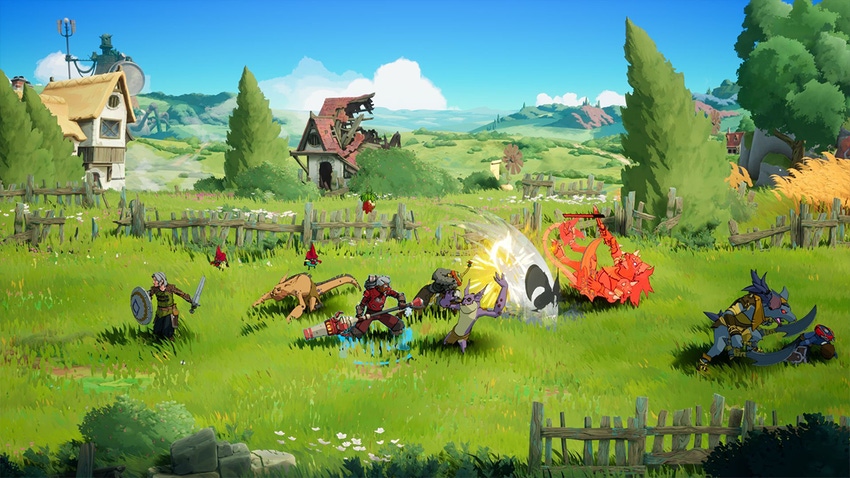Rapid prototyping the "difference maker" when developing Towerborne
Stoic CEO and president Trisha Stouffer explains how The Banner Saga developer built a multi-faceted combat system for its upcoming action-RPG.

This interview has been edited for clarity
The Banner Saga developer Stoic is pushing into uncharted territory with Towerborne.
The studio's latest project is a vibrant co-op adventure that allows up to four players to join forces and rebuild civilization as an "Ace," immortal heroes who must venture into the wilds of a post-cataclysmic world to save humanity from a looming evil.
At its core, the title is a slick action-RPG built around a combat system inspired by classic beat-em-ups. As they explore the world, players must battle unique enemies across a variety of biomes to unlock new equipment, weapons, and abilities so they can better protect The Belfry, a towering citadel that has become humanity's last holdout.
Stoic set out to create a combat system that doesn't restrict players by funneling them into classes, instead letting them hone their playstyle by experimenting with four weapon types: War Clubs, Gauntlets, Dual Daggers, and Swords & Shields. Each one facilitates special moves that can be mixed and matched depending on how players want to play, letting players further refine their approach. Then, there are Umbra, magical creatures that players can befriend to obtain unique combat abilities—such as a ward of protection or bombastic ranged attack.
Those elements intersect to turn combat into a frenetic, deeply engaging affair, with multiple heroes combining a range of light, heavy, and special attacks in tandem to carve through foes like butter. Stoic is leaning on that old adage of 'easy to learn, hard to master' in a bid to ensure that everybody from novice button-mashers to seasoned combo-junkies can work together as a collective and have a meaningful impact on the battlefield.
After taking Towerborne for a spin at Gamescom 2023, we caught up with Stoic CEO and president Trisha Stouffer to learn how the studio built and balanced a combat system that effectively combines so many disparate elements.
Paper ideas can only take you so far
"We started by creating a grid of nine. A grid of nine weapons. A grid of nine enemies. A grid of nine Umbra. Then we asked 'how will these elements play together if we combined them all together?' 'Do we have enough variation in here?' They need to be complementary, and some need to overlap—but not too much," explains Stouffer during a follow-up chat after the conference.
"That grid of nine is then tweaked again and again and again. Because we've got a pipeline that starts with a napkin drawing then maybe an animatic—and that pipeline is quite long when it comes to implementing a new enemy or weapon or Umbra, so we try to prototype it quickly enough so that we can get it into the game and get a feel for it."

Building a system with so many interlocking parts meant Stoic placed a huge emphasis on rapid prototyping. Stouffer says it doesn't really matter what ideas look like on paper; you need to translate them into something tangible so you can see how they'll interact and start making the necessary adjustments.
"[Once we've got a prototype], we can look at how two enemies or two weapons play together, so it's really about how quickly can we reach that prototyping stage and start playing with it," she adds.
"Figuring out what the pipeline needs to be [is important], but so is getting something into the hands of people who can actually play it. You're searching for the fun, and you won't find it on paper or in a write-up. So, the quicker you can get to that—even if you're sharing something in a rough state without animation or VFX—and start getting feedback, the better. That's been the biggest difference maker for us."
Playtesting enabled Stoic to address "blind spots"
Although Stoic was quick to prototype, the studio wasn't always quick to toss unruly ideas onto the scrap heap. "We held onto some ideas a bit longer than we should have," says Stouffer, noting that the team often succumbed to the sunk cost fallacy and struggled to ditch concepts that simply weren't fun.
It's a scenario that underlines the importance of consistent playtesting, with Stouffer explaining that Stoic tests combat multiple times a week and leverages user research to regularly put the project into the hands of players. "When you're that close to game development, there's always something you're going to be blind to, because your brain fills in a gap that it shouldn't be filling in," she says.
"In terms of knowing when to stop iterating, the team are going to keep going until we're like 'you have to stop.' We often talk about 'how would we feel if this shipped today?' Would we feel good? If not, then okay, let's see what we can do. But it's going to be a living game. It's perpetual. So we'll have the opportunity to keep making tweaks while collecting valuable feedback from players themselves."
Being receptive to player feedback will be crucial to the ongoing development of Towerborne, which is being pitched as a seasonal experience, but Stouffer says you can't just incorporate every request. "It's about listening to what players are asking for and then figuring out how to feather that into what you already have," she continues. "It still has to work within the balance of the game."
Towerborne is heading to PC and Xbox Series X | S in 2024.
Read more about:
FeaturesAbout the Author(s)
You May Also Like









